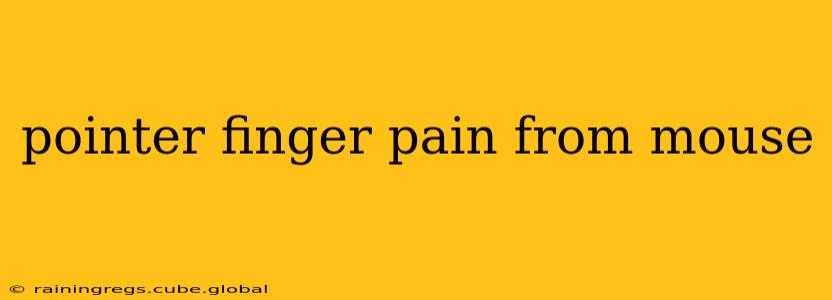Many of us spend hours each day using a computer mouse, making pointer finger pain a surprisingly common complaint. This pain can range from a mild ache to a sharp, debilitating stabbing sensation, significantly impacting productivity and quality of life. Understanding the causes, prevention strategies, and treatment options is crucial for managing and overcoming this issue. This comprehensive guide will explore these aspects, answering common questions and providing actionable advice.
What Causes Pointer Finger Pain from Using a Mouse?
Pointer finger pain stemming from mouse use is often related to repetitive strain injuries (RSIs). These injuries occur when the same movements are repeated over and over, leading to overuse and inflammation of the tendons, muscles, and nerves in the hand and wrist. Several specific conditions can contribute to this pain:
-
De Quervain's Tenosynovitis: This affects the tendons that control thumb movement, but often causes pain radiating into the pointer finger. It's characterized by pain at the base of the thumb and wrist, often worsened by gripping or pinching motions.
-
Carpal Tunnel Syndrome: While primarily affecting the median nerve, carpal tunnel syndrome can also cause pain and numbness in the pointer finger, as well as the thumb, index, middle, and ring fingers.
-
Trigger Finger: This condition involves a tendon in the finger catching or locking during bending or straightening, often accompanied by a snapping sensation. It frequently affects the pointer finger due to its frequent use.
-
Tendonitis: Inflammation of the tendons in the pointer finger, resulting from repetitive movements and overuse.
-
Muscle Strain: Overexertion of the muscles in the hand and forearm can lead to muscle strain and pain, especially in the pointer finger, which is heavily involved in mouse manipulation.
-
Poor Posture: Maintaining incorrect posture while using a mouse can contribute significantly to hand and wrist strain, increasing the risk of pointer finger pain.
How Can I Prevent Pointer Finger Pain from Using a Mouse?
Prevention is key when it comes to RSI. By incorporating these preventative measures into your daily routine, you can significantly reduce your risk of developing pointer finger pain:
-
Ergonomic Setup: Invest in an ergonomic mouse designed to support the natural position of your hand and wrist. Ensure your keyboard and mouse are positioned at a comfortable height and distance, allowing your elbows to rest comfortably at your sides.
-
Proper Posture: Maintain good posture while working. Sit upright with your back straight, feet flat on the floor, and shoulders relaxed. Avoid hunching over your desk.
-
Regular Breaks: Take frequent breaks throughout the workday. Every 30-60 minutes, stand up, stretch your hands and wrists, and move around to improve circulation and relieve tension.
-
Stretching Exercises: Incorporate simple stretches specifically designed to alleviate hand and wrist tension. These can include wrist extensions, flexions, and finger stretches.
-
Strengthening Exercises: Strengthening the muscles in your hands and forearms can help improve stability and reduce strain. Simple exercises such as hand squeezing, wrist curls, and finger lifts can be beneficial.
-
Mouse Usage Techniques: Avoid clenching your fist while using the mouse. Instead, use a relaxed grip and use your whole arm for larger movements instead of just your wrist and fingers.
What are the Treatments for Pointer Finger Pain from Mouse Use?
Treatment options for pointer finger pain caused by mouse use depend on the severity of the condition. Mild cases often respond well to conservative measures, while more severe cases may require more intensive interventions:
-
Rest: Avoiding activities that aggravate the pain is crucial. This may involve taking time off from work or modifying your tasks.
-
Ice Packs: Applying ice packs to the affected area can help reduce inflammation and pain.
-
Over-the-Counter Pain Relievers: Nonsteroidal anti-inflammatory drugs (NSAIDs), such as ibuprofen or naproxen, can help manage pain and inflammation.
-
Physical Therapy: A physical therapist can guide you through specific exercises and stretches to improve strength, flexibility, and range of motion. They can also teach proper posture and ergonomic techniques.
-
Splints or Braces: In some cases, wearing a splint or brace can help immobilize the affected area, allowing it to heal.
-
Corticosteroid Injections: For more severe cases, a doctor may inject corticosteroids into the affected area to reduce inflammation.
-
Surgery: In rare instances, surgery may be necessary to repair damaged tendons or nerves.
Does using a vertical mouse help with pointer finger pain?
Vertical mice are designed to reduce wrist strain by promoting a more natural hand position. While they don't guarantee pain relief for everyone, many users find them beneficial in reducing the strain on their wrists and fingers, potentially lessening pointer finger pain.
Can changing my mouse help with pointer finger pain?
Yes, switching to a different type of mouse, such as an ergonomic mouse or a vertical mouse, can significantly reduce strain and potentially alleviate pointer finger pain. The ideal mouse will depend on your individual needs and preferences.
How long does it take for pointer finger pain to heal?
The healing time for pointer finger pain from mouse use varies depending on the severity of the condition and the individual's response to treatment. Mild cases may heal within a few weeks, while more severe cases may require several months of treatment.
By understanding the causes of pointer finger pain from mouse use, implementing preventative measures, and seeking appropriate treatment, you can protect your hand health and maintain productivity. Remember, early intervention is key to preventing chronic pain and long-term disability. Consult a healthcare professional for diagnosis and personalized treatment recommendations if your pain persists or worsens.
